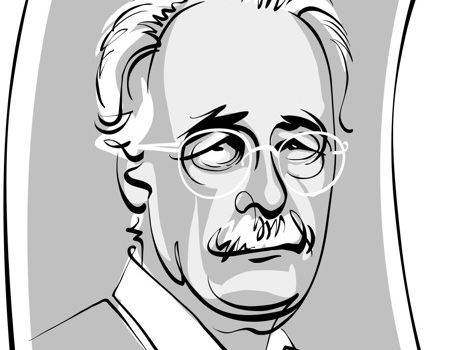NOTES ON A VOICE: W.G. SEBALD

From INTELLIGENT LIFE Magazine, Spring 2011
The
essential theme of W.G. Sebald’s books is memory: how painful it is to
live
with, how dangerous it can be to live without it, for both nations and
individuals. The narrators of his books—of which “Austerlitz”
and the four
linked narratives of exile in “The Emigrants” are the most
compelling—live in a
state of constant reminder. Everything blends into everything else:
places,
people, their stories and experiences, and above all different times,
which
seep into each other and blur together, often in long, unmoored
passages of
reported speech. The narrator of “Vertigo” gives a concise account of
this
method: “drawing connections between events that lay far apart but
which seemed
to me to be of the same order”.
Sebald, born in Bavaria in 1944, spent most of his adult life as an academic in Britain. He died in Norfolk in 2001, after having a heart attack at the wheel of his car. He wrote in German, but worked closely with his English translators, Michael Hulse and Anthea Bell. In either language, his voice is mesmeric.
Sebald, born in Bavaria in 1944, spent most of his adult life as an academic in Britain. He died in Norfolk in 2001, after having a heart attack at the wheel of his car. He wrote in German, but worked closely with his English translators, Michael Hulse and Anthea Bell. In either language, his voice is mesmeric.
Key
decision:
To invent
his own hybrid form. Sebald’s main works blend travelogue and
meditation,
fiction with history and myth. They have a narrator who both is and is
not
Sebald himself: a spectral character who is sensitive, digressive and
restless,
compulsively peregrinating around Europe and its past.
Strong
points:
Finding a
voice to fit his preoccupations. His sentences are looping, reflexive,
moving
forward yet endlessly turning back on themselves. By the time he wrote
“Austerlitz”, the last book he published before his death, Sebald had
more or
less dispensed with paragraph breaks altogether. This fluidity creates
a
feeling, as the character Austerlitz says of his own sense of history,
that
“time will not pass away, has not passed away, that I can turn back
after
it”—clauses that are themselves part of a much longer, circular
sentence. This
is a style that tries to unbury the dead through syntax.
Golden rule:
Obliqueness,
or, as one critic put it, tact. Sebald’s prose is finely wrought yet
unflashy.
His punctuation is rarely more exotic than the comma; his vocabulary is
unadorned. Similes are uncommon: he deals instead in a sort of luminous
reality. As in style, so in content. Asked about his approach to the
horrors of
20th-century history—his work circles the Nazi Holocaust as if it were
a
mountain—Sebald once said that his aim was to intimate “to the reader
that
these subjects are constant company; their presence shades every
inflection of
every sentence one writes”, without describing the camps and
catastrophes
directly. It is loss, rather than bloodshed, that his books lament.
Favourite
trick:
Putting
pictures into the text that subtly reinforce these themes. They are
black-and-white, uncaptioned and unexplained—pictures of people, but
also train
tickets, restaurant receipts, maps and other relics. They seem to
advertise the
veracity of the stories they appear in, yet they are artful and
calculated. The
images are often poignant, at once bringing back forgotten people and
confirming
that they are irrevocably lost. They point up a question that is at the
heart
of Sebald’s work: why do we cling on to some things from the past while
the
rest of it escapes us?
Role models:
In the way
it samples and fractures different subjects and stories, Sebald’s work
is
almost post-modern. Jorge Luis Borges is cited by some as a key
influence on
him. And yet his sentences are also plangently old-fashioned, sometimes
reminiscent, for readers in English, of medieval periods. There are
echoes of Thomas
Malory and Thomas Browne and, in his dextrous weaving of complementary
tales,
of Ovid.
Typical
sentence:
Many of the
finest are too long to cite, so this, from “The Emigrants”, will have
to do:
“And so they are ever returning to us, the dead.”
Vintage
Classics reissue three of Sebald’s books this year: "The Emigrants",

Comments
Post a Comment